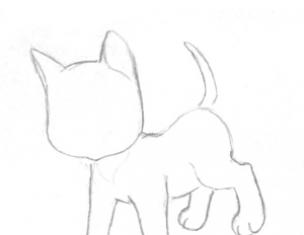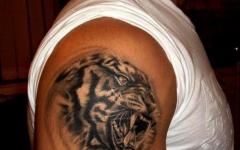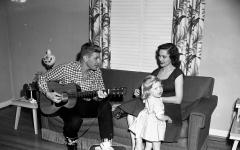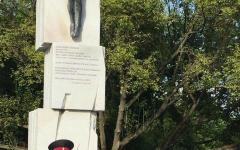Julia Trishina
Dear Colleagues!
I bring to your attention didactic game, which can be used on social and communicative development in classes on familiarization with the outside world, as well as in classes aimed at the gender development of the child. A game develops logical thinking memory, imagination and fine motor skills hands
Didactic game for children 3-4 years old on the topic: "Studying the human body" Goal and tasks:
To form fundamental positive achievements in the development of the personality (I-image, respectful attitude and a sense of belonging to one's own and the opposite sex. To cultivate a culture friendly relations in the children's team, tolerant attitude towards boys and girls. develop speech children to fix in speech the names of body parts.
Game progress
Tell the child about man is a living being, which has a shell, like every living being - body. Look at the picture with your child human body(boy and girl, fix the name of all body parts with him, ask the child to show body parts on himself or on another child.

Invite the child to fold the cut picture (boy or girl) from parts of the picture.
A game held at the table.


You can play with 1, 2, 3 children, during the game, one child can be given the right to control the correct execution of the tasks of the game. The winner is the one who correctly and quickly collects the picture.
Related publications:
Business game "We study the Federal State Educational Standard of Preschool Education" Business game "Learning GEF preschool education» PURPOSE: activation of the mental activity of teachers in the knowledge of the basic provisions.
Goal: Learn to analyze the simplest circuit images of human poses. To form the ability to understand and perform tasks related to the direction.
Abstract of the lesson on valeology "We study our body" Integration educational areas: speech development, social and communicative development, physical development, artistic and aesthetic.
Abstract of the lesson on the world around "Human Body" Purpose: To form the first concepts about your body, organism. Help children to realize themselves as a person, to find common ground with other people. Bring up.
KVN on valeology in the preparatory school group "Human Body" SUMMARY of a lesson in valeology in the KVN group “Human Body” preparatory to school Tasks: generalization of elementary knowledge of children about work.
Abstract of a lesson on valeology in the senior group “The human body. sense organs." Abstract of a lesson on valeology in the senior group “The human body. sense organs." Purpose: To give children ideas about the senses, like ours.
Journey to the experimental laboratory Purpose: expanding children's knowledge about the structure of the human body Tasks: developing.
An easy way to learn the structure of the human body is to play the game "Build the Skeleton" with the kids. Focusing on the age of the child, you can complicate / simplify the rules of the game, choose the appropriate picture. We share a simple idea of creating a game with your own hands.
en.wikipedia.org
Find a suitable picture on the Internet and print it on a printer. Cut out individual elements and stick on cardboard (for strength). If desired, you can paste over the parts with tape on both sides.
 allfortheboys.com
allfortheboys.com
When everything is ready, tell the kid what "spare parts" our skeleton consists of. All bones can be conditionally grouped as follows:
- bones of the head (skull);
- bones of the body (vertebral column, rib cage);
- bones of the upper limbs (shoulder, forearm, hand);
- bones of the lower extremities (pelvis, thigh, lower leg, foot).
If this information is not enough for your inquisitive little one, study the skeleton in more detail, tell about the functions of each group of bones. Ask the child to move around and observe the work of a particular part of the body.
The adult human skeleton consists of 200-218 bones.
 allfortheboys.com
allfortheboys.com
Game options
There are many game options:
- Just fold the "little man" like a puzzle.
- Hide the details in rice or any other cereal and give the child the opportunity to arrange real "excavations". Imagine with what passion a young paleontologist will collect the skeleton of an ancient man. You can come up with any story and dig up even Darwin himself.
- Play for speed. To do this, you need several printouts (according to the number of players). The sequence of moves is determined by the die. For example, who has more on the bones, he walks. Or who rolled a double on both dice, he has the right to attach one part of the skeleton.
- Play for luck. Print 2 sets and cut out not along the contour, but with simple rectangles. Turn the cards over and draw from the deck. In the process, you can change "spare parts". The one who collects his little man the fastest wins. You can come up with the rules yourself - it's even more interesting.
Cotton bud skeleton

Elena Levina
Didactic game« The human body»
Tasks:
educational:
Meet children with the structure of the human body, on the appointment of individual parts;
Form nouns with diminutive - affectionate suffixes;
Form plural nouns in the genitive case.
Educational:
Improve the lexical and grammatical structure.
Educational:
To develop the ability to follow and follow the rules, to wait for your turn.
gaming:
Do the right thing and you win.
Rules:
Organizational:
Participate from 2 to 6 children;
- a game held at the table;
The game is played by the teacher.
Disciplinary:
Listen carefully to the teacher;
We answer in turn;
When one speaks, the others listen;
During the game, you cannot get up from the table, you need to achieve the result of the game.
Gaming:
Whoever has the most chips wins won.
Attributes for the game:
Small cards showing parts of the body (head, neck, shoulder, arm, leg, back, stomach, chest, hand, finger, wrist, knee, elbow, foot, heel, eye, nose, mouth, eyebrow, cheek, ear, chin, eye, forehead) and a question mark. A coin on one side has a large circle - a small circle, on the other one circle - a lot of circles.
1 game option "Call it sweetly"
question: “You need to affectionately name what is drawn in your picture”. For example:
head - head
Neck - neck
shoulder - shoulder
Hand - pen
leg - leg
Back - back
Belly - belly
chest - chest
Finger - finger
Knee - knee
Elbow - elbow
Eye - eye
Nose - spout
Mouth - mouth
Ear - ear
Chin - chin
Eye - eye
forehead - forehead
Cheek - cheek
Heel - heel
A game
Result:
won.
2 game option "Call by example"
The cards are face down on the table. The teacher offers to take turns taking one card at a time and name what is drawn on it. Then the teacher draws attention to the sign question: .
For example:
Head (and they)– heads
Neck - necks
Shoulder - Shoulders
Hand - hands
Leg legs
Back - backs
Belly - bellies
chest - chest
finger - fingers
Knee - knees
Elbow - elbows
Eye - eyes
Nose - noses
Mouth - mouths
Ear - ears
Chin - chins
Eye - eyes
Forehead - foreheads
Cheek - cheeks
Heel - heels
A game continues until the cards run out. For each correct answer, the child receives a chip.
Result:
The child answered correctly and received a chip. Whoever collects the most chips won.
3 game option "One is Many"
The cards are face down on the table. The teacher offers to take turns taking one card at a time and name what is drawn on it. Then the teacher draws attention to the sign question: "You need to name the object according to the model".
For example:
Head (Many things)– heads
Neck - neck
Shoulder - shoulders
Hand - hands
Leg - foot
Back - back
Belly - belly
Chest - breasts
finger - fingers
knee - knee
Elbow - elbows
eye - eye
Nose - noses
Mouth - mouths
Ear - ears
Chin - Chin
eye - eye
Forehead - foreheads
Cheek - cheek
Heel - heels
A game continues until the cards run out. For each correct answer, the child receives a chip.
Result:
The child answered correctly and received a chip. Whoever collects the most chips won.
4 version of the game with a coin (on one side of the coin depicted: big circle - small circle, on the other side one circle - many circles)
The cards are face down on the table. The teacher offers to take turns taking one card at a time and name what is drawn on it. Then the teacher draws attention to the sign question: "You need to flip a coin and see what task you got". If the coin lies on the side on which the large circle and small circles are drawn, the children should affectionately name the object that is drawn in their picture. If the coin lies on the side on which one circle and many circles are drawn, the children must name the object in the plural in the genitive case.
Result:
The child answered correctly and received a chip. Whoever collects the most chips won.
Arefieva L. N. Lexical Topics for the development of speech children 4-8 years old. Toolkit. - M .: TC Sphere, 2004.
Krupenchuk OI Teach me to speak correctly! A guide to speech therapy for children and parents. - St. Petersburg: Publishing House "Litera", 2003.
Oregon Scientific introduces a novelty "Entertaining Anatomy". The device is designed for children aged 5 years and over. The main purpose is to convey information about the complex and amazing systems of the human body with ease and in a game mode.
Device description
Over 20 themes in 5 different game modes. More than 150 informative points for using the "Smart" pen. And that's not all the novelty can boast of. Regardless of which role the child chooses to play, he will receive answers to his questions, remember the names and get acquainted with the functions of each organ. While experimenting, the child will spend time exploring the mysteries of the human body!The interactive device is designed specifically to help children understand the structure of a person and his individual organs. For this, the latest technology for communicating with the user through a "smart" pen was used. Oregon Scientific device microcode reading technology is used in the production of educational products. With the help of the code, when you hover over the cursor, the smart pen reads information on the selected organ or body area and plays a specific comment.
Elements
The device kit contains the main parts of the body, which are divided into two categories - the bone structure and body organs.There are 16 removable parts in total:
- 7 elements of the human bone structure;
- 9 elements of the formation of human organs.
All elements are held on magnets and, if desired, can be removed for detailed study by the child.

Booklet and poster
The device comes with a booklet that will tell the child the correct name of each part of the body. An additional poster in A3 format will allow you to delve into the study in more detail and clearly understand all the complex functions of the body.Benefits of the game
"Entertaining Anatomy" opens up new perspectives in the development of children's curiosity, with its help they will be able to:- Expand your horizons with new knowledge about the medical profession;
- Enrich your knowledge about the structure of the human body and internal organs through game programs;
- Comprehensively understand the structure of the body;
- Get an idea about a healthy lifestyle and nutrition.
The cost of the novelty is 7990 rubles, in the near future the set will be available in the stores of the " Child's world", "Eldorado" and others.
Card file of didactic games for the development of ideas about the human body in older children preschool age
Mubarakzyanova Serine Vrezhikovna, junior educator Municipal budgetary preschool educational institution « Kindergarten"Fairy tale" Muravlenko, Yamalo-Nenets Autonomous Okrug.Description: a set of didactic games for the development of ideas about the human body will be useful for educators senior group and parents of children in this age group.
Target: The development of children's ideas about the human body.
Tasks:
1) To form children's ideas about the main parts of the human body.
2) Consolidate children's ideas about parts of the face (nose, mouth, eyebrows), consolidate preschoolers' knowledge of sexual and age features of people.
3) To form ideas in older preschool children about the location of internal organs in the human body (heart, stomach, liver, kidneys, lungs).
4) Expanding preschoolers' understanding of key components healthy lifestyle human life.
Didactic game "Get to know yourself"
Target: To form children's ideas about the main parts of the human body.Equipment: Mirror.
Game progress:
Educator: Guys, today I want to invite you to get acquainted with the structure of the human body. Of course, each of you knows how the human body is arranged in general, but in order to consolidate this knowledge, I propose to learn the verse with the “Get to Know Yourself” movements:
Everyone should have
Very smart head (you need to bring your hands to your head, shake it)
I give her the best I can
The head sits on the neck (stroke the neck from top to bottom three times)
Belly, back chest (alternately point to each part of the body with your hands)
Together they are called "torso" (wrap your arms around yourself)
I ate all the food, and now
My stomach filled up. (pat yourself on the stomach)
Don't forget to walk
Cover your chest from the wind! (circle the chest with your hands)
Hands - to caress, work,
Drink water from a mug (open and put forward)
The boys sit on the arm -
Very friendly funny fingers. (wiggle fingers)
Run along the path
Frisky legs (stomp your feet, imitating running)
Stumbled across Genka
And hurt my knee (pat your knees).
Didactic game "My body"
Target: To consolidate children's ideas about parts of the human bodyEquipment: Mirror
Game progress:
Educator: Guys, please come to the mirror. Each of you sees yourself in the mirror every day, but how often do we think about how a person works? Let's play a little with you and remember the main parts of the human body. I will name the words, and you will have to change one or more letters in the word so that we get the name of one of the parts of the human body. After you complete the task, we will need to show this part of the body together. Let's start:
Nightingale - Head (children pat their heads)
Bobik - Lobik (point to forehead)
Coconut - Spout (Close your eyes and touch your finger to the tip of your nose)
Lumps - Cheeks (rubbing cheeks with palms)
Oaks - Teeth (teeth chattering)
Paints - Eyes (open their eyes wider, look at how many colors and colors are around)
Sisters - Eyelashes (flapping eyelashes)
Naughty - Ears (touching ears)
Turkey - Neck (stretch neck)
Grasshoppers - Hangers (simultaneously raise and lower shoulders)
Grips - Pens (grab your body with your arms)
Boys - Fingers (show flashlights, wiggle fingers)
Duck - Breast (push chest forward)
Hippo - Belly (put belly forward)
Deer - Knees (bend knees)
Boots - Legs (alternately put forward the left, right sock, moving the foot in place)
Educator: Here are some good fellows! Now we have repeated the structure of the human body, and when we look at ourselves in the mirror, we will know where which part of the body is.
Didactic game "My light, mirror, say"
Target: To consolidate children's ideas about the parts of the face (nose, mouth, eyebrows), to consolidate the knowledge of preschoolers about the sex and age characteristics of people.Equipment: Pictures depicting parts of a person's face, additional details? Wigs, butterfly, women's jewelry, mustache, beard, hats.
Game progress:
Educator: Guys, look, we received a package from our old friend - the Good Wizard. He asks us to help us understand these pictures and make portraits of people. The Wizard also asks to characterize each resulting portrait and come up with a name for it. Let's complete the task of our friend?
Children are given pictures, asked to make a face on them. If preschoolers find it difficult, they are asked: “What do you see in the picture?”, “What parts of the face are shown in it?”. Children are also invited to study (consider) each other, to identify the main differences in facial features of boys and girls. Then it is proposed to come up with faces from empty pictures (face models) - arrange eyebrows, eyes, nose, mouth, ears, and also supplement the pictures with wigs, butterflies, women's jewelry, mustaches, beards, hats - in accordance with the gender of the face for which the portrait is being drawn.
Game options: Also, children can be offered to play the game "Emotions" - pick up a certain emotion, establish a relationship with the position of the lips, the expression of the eyes, etc. Also, during the game, suggestive questions about the reasons for the appearance of certain emotions - for example, “Is this person sad or cheerful? Why is he sad? What happened to him? How to help him overcome sadness and become cheerful again?
Didactic game "What's inside me?"
Target: To form ideas in older preschool children about the location of internal organs in the human body (heart, stomach, liver, kidneys, lungs).Equipment: Valeological apron.
Game progress:
It is necessary to prepare in advance a valeological apron on which to place the organs in accordance with their placement in the human body.
You should also tell children about the functional content of a particular organ, for example: the lungs are designed to filter the air that we breathe.
The participants in the game take turns putting on an apron, applying the attributes of the organs, thereby forming ideas about their location.
Didactic game "Collect a little man"
Target: Consolidation of children's ideas about the structure of the human body.Equipment: Geometric shapes, human body template.
Game progress: children are invited to collect a little man by placing geometric shapes in the right order, in the right place.









